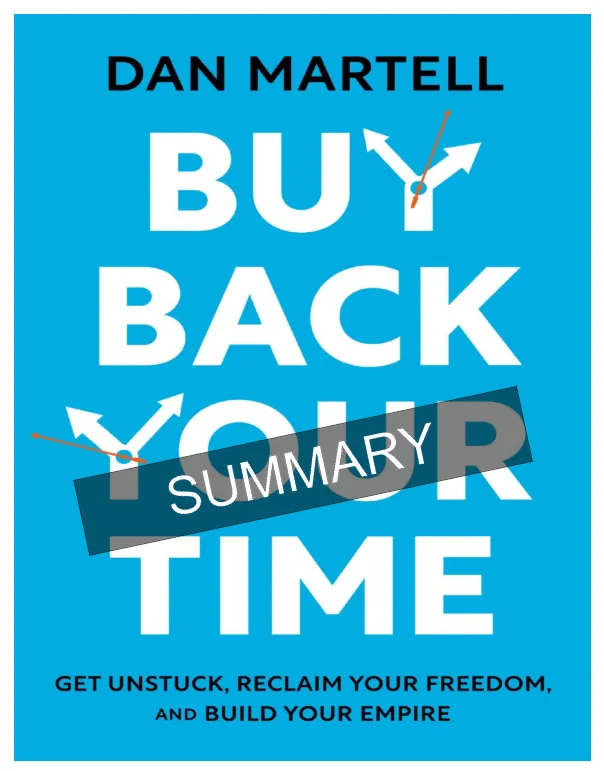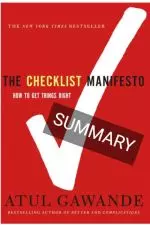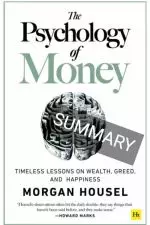Buy Back Your Time Book Summary
The Complete Guide to Buying Back Your Time: A Comprehensive Summary of Dan Martell's Revolutionary Business Framework
Transform your business and life by mastering the art of time buyback with this complete chapter-by-chapter breakdown of proven strategies.

Introduction: From Chaos to Control
Dan Martell's journey from troubled youth to successful entrepreneur reveals a crucial insight: the "Get Shit Done" (GSD) mentality that drives early success eventually becomes the very thing that destroys it. This comprehensive guide will show you how to escape the trap of trading time for money and instead build a business that buys back your freedom.
Chapter 1: The Buyback Principle Foundation
The Core Problem: Stuart's Breakdown
Stuart, a successful entrepreneur with 10 employees and 640,000 active users, experienced panic attacks at Disneyland because he was doing everything himself. His story illustrates the universal entrepreneur trap: believing that personal involvement in every task is necessary for success.
The Buyback Principle
"Don't hire to grow your business. Hire to buy back your time."
This principle shifts your mindset from thinking about roles and organizational charts to focusing on the most valuable asset: your time.
The Pain Line
Every entrepreneur hits a wall around $1 million in revenue and 12 direct reports where growth becomes painful. When you reach this point, you'll either:
- Sell - Exit because the pain is too great
- Sabotage - Unconsciously make decisions that halt growth
- Stall - Consciously decide not to grow (which actually means dying)
The Buyback Loop: Your Success Formula
Audit → Transfer → Fill
- Audit: Identify tasks that drain energy and don't require your unique skills
- Transfer: Move those tasks to others who can do them 80% as well
- Fill: Use freed time for high-value activities that light you up and make money
Systems Beat Goals
Focus on creating repeatable systems rather than just setting goals. Winners and losers often have the same goals—the difference is in their systems.
Chapter 2: The DRIP Matrix - Your Time Management Framework
Understanding the Four Quadrants
The DRIP Matrix categorizes every task based on two factors: how much money it makes you and how much energy it gives or takes.
Delegation Quadrant (Low Money + Drains Energy)
- Administrative work, billing, scheduling
- Action: Eliminate these tasks ASAP using your Buyback Rate
Replacement Quadrant (High Money + Drains Energy)
- Important tasks like sales, marketing, onboarding
- Action: Systematically replace using the Replacement Ladder
Investment Quadrant (Low Money + Gives Energy)
- Exercise, family time, hobbies, learning
- Action: Always maintain some time here for life balance
Production Quadrant (High Money + Gives Energy)
- Your unique genius zone activities
- Action: Spend maximum time here—this is your goal
Calculate Your Buyback Rate
Formula: (Annual income ÷ 2,000 hours) ÷ 4 = Your Buyback Rate
This is the maximum hourly rate you should pay others to do tasks you don't enjoy. If you make $200,000/year, your Buyback Rate is $25/hour.
The 80% Rule
Remember: "80% done by someone else is 100% freaking awesome." Stop demanding perfection and start demanding your time back.
Chapter 3: Defeating the 5 Time Assassins
Understanding Chaos Addiction
Many entrepreneurs develop an addiction to chaos due to challenging childhoods. While this chaos-handling ability creates entrepreneurial advantages, it can also sabotage success.
The 5 Time Assassins
- The Staller: Hesitates on big decisions, missing opportunities
- The Speed Demon: Makes rapid decisions without reflection, repeating mistakes
- The Supervisor: Micromanages instead of training, creating dependency
- The Saver: Hoards money instead of reinvesting in growth
- The Self-Medicator: Uses vices to celebrate wins or escape failures
Defeating Your Assassin
- Identify which assassin affects you most
- Recognize the pattern when it appears
- Create systems to counteract the behavior
- Get accountability from others
Chapter 4: Master the 3 Trade Levels
The Three Types of Traders
Level 1: Employee - Trades time for money
- Even business owners can be employees of their own company
- Limited by personal time capacity
Level 2: Entrepreneur - Trades money for time
- Uses Buyback Rate to purchase time from others
- Focuses on building systems and processes
Level 3: Empire-Builder - Trades money for more money
- Time is completely bought back
- Focus on investments and strategy
The Time and Energy Audit
Track every 15-minute block for two weeks:
- Note the task and time spent
- Assign dollar values ($ to $$$$)
- Highlight energy impact (red = draining, green = energizing)
- Prioritize eliminating red $ tasks first
Making Smart Trades
- Delete unnecessary work
- Delegate to current team members
- Find creative solutions using your Buyback Rate
Chapter 5: The Replacement Ladder - Your Systematic Upgrade Path
The 5-Rung System
Climb these rungs in order to systematically buy back your time:
Rung 1: Administration
- Key Hire: Administrative Assistant
- Feeling: Stuck → Better
- Ownership: Inbox and Calendar
Rung 2: Delivery
- Key Hire: Head of Delivery/Customer Success
- Feeling: Stalled → Unstuck
- Ownership: Onboarding and Support
- Pro Tip: Use the 10-80-10 rule (you do first 10%, they do middle 80%, you finish last 10%)
Rung 3: Marketing
- Key Hire: Head of Marketing
- Feeling: Friction → Smooth
- Ownership: Campaigns and Traffic
Rung 4: Sales
- Key Hire: Sales Representative
- Feeling: Smooth → Freedom
- Ownership: Calls and Follow-up
Rung 5: Leadership
- Key Hires: All department heads
- Feeling: Freedom → Flow
- Ownership: Strategy and Leadership
Key Implementation Points
- Follow the ladder in order
- Don't skip rungs based on company size
- Revenue increases at each rung fund the next hire
- Your feeling indicates which rung you're currently on
Chapter 6: Clone Yourself with an Administrative Assistant
Why Every Entrepreneur Needs an Assistant
An administrative assistant is non-negotiable. They provide:
- Baggage-free execution (no emotional attachment)
- Rule-following without exceptions
- Prevention of dropped balls
- Calendar and inbox management
Two Core Responsibilities
1. Calendar Management
- Set availability windows
- Batch similar meetings
- Protect deep work time
- Handle all scheduling requests
2. Inbox Management with Email GPS Create these email folders/labels:
- ! Your Name: Only items requiring your personal attention
- 1. To Respond: Assistant will handle
- 2. Review: Items needing your input
- 3. Responded: Completed items for your review
- 4. Waiting On: Pending external action
- 5. Receipts/Financials: All financial items
- 6. Newsletters: Content for later consumption
The Sync Meeting
Meet with your assistant every other day using this 7-point agenda:
- Off-load your action items
- Calendar review (next 2 weeks)
- Past meetings follow-up
- Your action items
- Project feedback loop
- Email review
- Questions for you
Chapter 7: Building Playbooks for Predictable Results
The 4 Cs Framework
1. Camcorder Method
- Record yourself doing tasks 3 times while talking through each step
- Creates training videos without extra time investment
- Captures nuances and variations
2. Course (High-Level Steps)
- Document 5-10 bullet points for each task
- Don't over-detail—aim for 80% coverage
- Think guidance, not micro-management
3. Cadence (Frequency)
- Daily, weekly, monthly, quarterly requirements
- When tasks should be completed
- Dependencies and timing
4. Checklist (Non-Negotiables)
- Critical items that must be verified
- Quality control measures
- Success criteria
Playbook Creation Strategy
- Start with your biggest pain point
- Record yourself doing the task
- Have the new hire create the playbook from your videos
- Review and refine together
- Use as training tool for future hires
Benefits of Playbooks
- Unlimited predictability beats intermittent quality
- Scales your knowledge across the organization
- Reduces training time
- Maintains quality standards
Chapter 8: Design Your Perfect Week
The Perfect Week Benefits
- Eliminates buffer time between tasks
- Optimizes energy throughout the day
- Prevents bleed time from meetings running over
- Identifies No Extra Time (N.E.T.) opportunities
Task Batching Strategy
Group similar activities together:
- All sales calls on specific days
- All meetings back-to-back
- Creative work during peak energy times
- Admin tasks during low energy periods
Perfect Week Design Process
- Be willing to iterate - Takes 2-3 weeks to optimize
- Honor your schedule - No buffer time means no flexibility for overruns
- Energy over time - Match tasks to your natural energy patterns
- Important work first - Schedule priorities before filling in gaps
- Batch everything - Minimize context switching
The "Hell Yeah!" Test
Only change your planned week for opportunities that make you say "Hell yeah!" Otherwise, stick to your plan.
Chapter 9: The 4 Essential Time Hacks
1. $50 Magic Pill
Give every team member a spending allowance ($50-$5,000 depending on role) to solve problems without approval. They must report spending at next meeting.
2. Sync Meetings with Repeat Agenda
Use the 7-point template from Chapter 6 for all assistant meetings. Creates consistency and covers everything systematically.
3. Definition of Done (DoD)
For every task assignment, specify completion criteria:
- Facts: Measurable outcomes required
- Feelings: How you should feel when it's complete
- Functionality: What it enables others to do
4. The 1:3:1 Rule
Before staff can bring you problems, they must:
- Define 1 specific problem
- Offer 3 possible solutions
- Make 1 recommendation
Destroying the Ego
These hacks require giving up being the hero with all the answers. You're empowering others to solve problems and grow capabilities.
Chapter 10: The "Test-First" Hiring Method
The 6-Step Hiring Process
1. Be Clear
- Know exactly what tasks you're hiring for
- Reference Replacement Ladder ownership responsibilities
- Don't let entrepreneur optimism cloud judgment
2. Cast a Wide Net
- Current team referrals (A-players attract A-players)
- Job boards and multiple platforms
- Reach out to admirable companies
- Use "advice" cold outreach approach
3. Give Candidates a Chance to Shine
- Require 3-minute video answering 5 questions
- Tests basic technology skills
- Filters for communication ability
- Most candidates self-eliminate here
4. Use Profile Assessments
- Test your entire team first to identify patterns
- Have final candidates take personality tests
- Look for complementary strengths to your weaknesses
- Don't make it a religion—use as one data point
5. "Test-First" Method
- Give representative project before hiring
- Always pay for test work
- Minimal instructions to test independence
- Predicts actual working relationship
6. Sell the Future
- Switch to selling mode after you've identified your choice
- Understand what the candidate wants in 5 years
- Connect your opportunity to their goals
- Sell hard—top talent has options
Key Hiring Insights
- 80% performance from someone else beats 100% from you if it frees you for higher value work
- Most people self-eliminate with proper filters
- Test projects reveal more than interviews
- Top performers want to work with other top performers
Chapter 11: Transformational Leadership
Moving Beyond Tell-Check-Next
Transactional Management: Tell what to do → Check if done → Tell what's next Transformational Leadership: Tell outcome → Measure progress → Coach to success
The Three Leadership Actions
1. Tell Outcome (Not How)
- "Blog posts must be error-free" vs "Spell-check every post"
- "Hit $100K in sales" vs "Make more calls"
- "Be GDPR compliant" vs "Take GDPR training"
- Shifts mental responsibility to the employee
2. Measure Progress
- Give everyone "one number" to track
- Examples: Sales quota, customer satisfaction score, absorption rate
- Creates clarity and motivation
- Enables self-correction
3. Coach to Success Use the CO-A-CH framework:
- COre issue: Identify the principle at stake
- Actual story: Share when you faced similar challenge
- CHange: Ask what they need to do differently
Benefits of Transformational Leadership
- Employees closer to problems often have better solutions
- Builds capability in your team
- Creates ownership and buy-in
- Scales your decision-making capacity
Chapter 12: The "F-Word" That Saves Businesses
Why Feedback Matters
70% of employees find life purpose in their work. Without feedback:
- Small problems become explosions
- Productivity stalls
- Star players leave
- Miscommunications multiply
The CLEAR Feedback Framework
C - Create warm environment
- Ask for positive feedback first
- Have them think of critical feedback (don't share yet)
L - Lead them to share critical feedback
- Ask them to share their concerns
- Position as wanting to become better leader
E - Emphasize
- Listen and repeat back what you heard
- Make sure they feel understood
A - Ask if there's more
- Often they start with something small
- Give them chance to share the real issue
R - Reject or accept the feedback
- Your choice whether to implement
- Thank them regardless
- If accepting, commit to specific change
Creating Feedback Culture
- Leader must go first and ask for feedback
- Make it safe to offer criticism upward
- Regular feedback prevents explosions
- Saves "A" players and reduces turnover
Chapter 13: Dream BIG. Achieve Bigger
Phase 1: Limitless Dreaming
Think without constraints:
- What would you do with unlimited resources?
- What problem would you solve for the world?
- What legacy would you leave?
Why Big Dreams Matter
- Drive innovation: Necessity creates invention
- Inspire others: Passion is contagious
- Crush distractions: Clear purpose eliminates time-wasting
- Simplify decisions: North Star guides choices
Phase 2: Create Clear 10X Vision
Transform dreams into specific details with four elements:
1. Team
- Who will be in the room with you?
- What expertise will you need?
- How many key players?
2. One Business
- Focus on becoming world-class in one area first
- Build skills, network, and resources
- Use success to fund other ventures
3. Empire
- Multiple companies or investments
- Overarching purpose or theme
- Philanthropic elements
4. Lifestyle
- Where will you live?
- How will you spend time?
- What hobbies and interests?
- Who will you be with?
Making It Real
- Create visual representation (PDF, vision board, desktop background)
- Include specific details, numbers, dates
- Describe with same precision as current situation
- Review regularly to guide decisions
Chapter 14: The Preloaded Year
From 10X Vision to Big Rocks
Create Checkpoints
- Work backward from 10-year vision
- Set 5-year, 3-year, 1-year milestones
- Include all four elements: team, business, empire, lifestyle
List Tactics for Next Checkpoint
- Brainstorm 10-20 strategies
- Ask mentors for input
- Don't self-censor during brainstorm
Score with ICE
- Impact: Financial effect on revenue (1-10)
- Confidence: Likelihood of success (1-10)
- Ease: How simple to implement (1-10)
- Select top 2-3 tactics as "big rocks"
Building Your Preloaded Year
1. Place Big Rocks First
- Personal: birthdays, anniversaries, vacations
- Business: conferences, product launches, key meetings
- ICE tactics from vision work
2. Batch Pebbles into Big Rocks
- Group related activities
- Example: All client touches in 2-day periods
- All international travel in one month
3. Add Maintenance
- Proactive energy management
- Quarterly getaways
- Post-conference recovery time
4. Insert Pebbles
- Regular recurring activities
- Weekly date nights, monthly board meetings
- Fill remaining calendar space
5. Stress Test
- Check energy flow between events
- Avoid conflicting demands
- Ask: "Will this be an amazing year?"
Working the Plan
- Honor your commitments to yourself
- Use "Hell Yeah!" test for changes
- Stick to plan 90-95% of the time
- Remember: More planning = more spontaneity
The 7 Pillars of Life Balance
Even while building your empire, maintain balance in:
- Health: Physical fitness and wellness
- Hobbies: Activities that recharge you
- Spirituality: Connection to something greater
- Friends: Maintaining relationships
- Love: Family and romantic relationships
- Finances: Money management and planning
- Mission: Purpose and meaning in work
Weekly Practice: Score yourself 1-10 in each pillar, focus on improving your two lowest scores.
Conclusion: The Buyback Life
Living the Principle
The Buyback Principle isn't a one-time activity—it's a lifelong philosophy:
- Constantly audit how you spend time
- Transfer low-value activities to others
- Fill freed time with Production Quadrant work
- Never retire from what you love
Building Your Empire
With 60+ years of productive life ahead:
- Think bigger than traditional retirement
- Use extra time to build multiple businesses
- Create lasting impact and legacy
- Enjoy the journey while building
Implementation Strategy
- Start immediately with your Buyback Rate calculation
- Hire an administrative assistant first
- Create your first Playbook for your biggest pain point
- Design your Perfect Week around energy patterns
- Climb the Replacement Ladder systematically
- Develop your 10X Vision and Preloaded Year
- Build feedback culture with transformational leadership
Final Mindset Shift
Stop waiting for "someday" to live the life you want. The Buyback Principle gives you the tools to create freedom today while building the empire of tomorrow. Your time is your most valuable asset—invest it wisely by buying it back and deploying it where only you can create value.
Remember: You're not just building a business, you're designing a life. Make it one you don't need to retire from.
📚 Related Reading
Build Your Foundation:
Atomic Habits Summary - Master the systems thinking that makes the Buyback Principle sustainable. Learn how to build the daily habits that support your Perfect Week and systematic time buyback.
Eat That Frog! Summary - Essential time management principles that complement your Perfect Week design. Learn Brian Tracy's 21 proven methods to stop procrastinating and focus on high-value tasks.
Implement the Systems:
The Checklist Manifesto Summary - Perfect companion for building bulletproof Playbooks. Discover how simple checklists can transform complex work and eliminate costly errors.
Advanced Strategies:
The Psychology of Money Summary - Understand the mental frameworks behind smart Buyback Rate decisions. Learn how psychology impacts financial choices and long-term wealth building.
This comprehensive guide provides all the frameworks, tools, and strategies from Dan Martell's "Buy Back Your Time." Start with calculating your Buyback Rate and hiring an administrative assistant, then systematically work through each framework to reclaim your freedom while building your empire.



